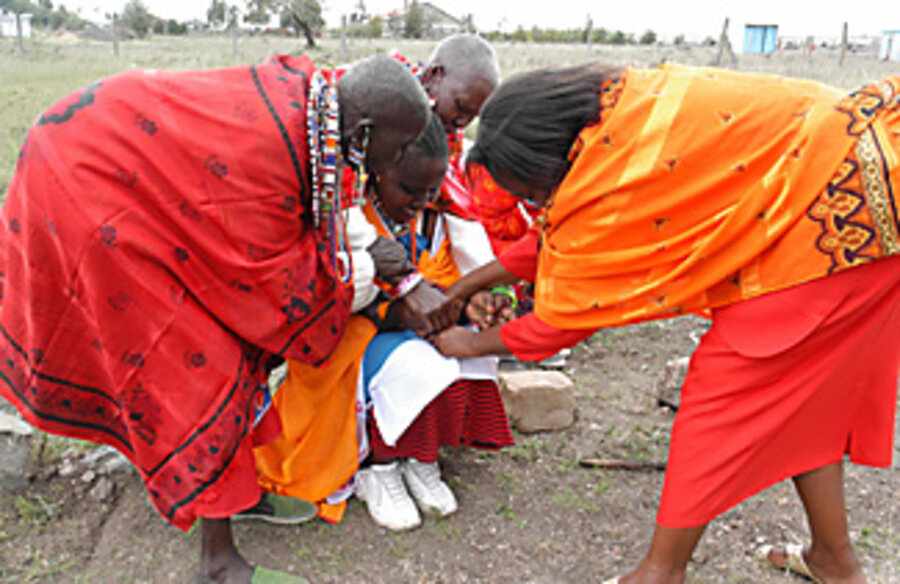In Kenya, a refuge from female circumcision
Loading...
| Narok, Kenya
Five years ago, when Millicent was 13 years old, her father told her it was time to leave school and get married. But first, he said, the Masai adolescent must be circumcised.
Millicent had her own ideas; she had learned at a recent village workshop about the dangers of female circumcision and early marriage. But her family was unsympathetic. "I was circumcised, your mother was circumcised," her grandmother told Millicent. Fighting back tears, she explains, "In my community, it is difficult for a girl who is not circumcised to get married."
Today, after a cousin who helped her run away, Millicent lives at the Tasaru Girls Rescue Center in Narok. There, she has continued her schooling and received an alternative rite of passage – part traditional rituals, part health class – which she hopes will allow her to be accepted by her community, if not her family, in the future.
"If I hadn't come here, I would be a mother of two or three children by now," says Millicent, now 18. "My community should understand, by not getting married early, I can get a better education, and a job to earn money for my family. For now," she looks out the door at the girls in the garden of the shelter, "this is my family."
Female circumcision (also known as female genital mutilation, or FGM) is persistent throughout the Horn of Africa and the Middle East, despite research showing it contributes to thousands of miscarriages and maternal deaths each year.
Changing an entire culture – particularly a very distinctive one, such as the Masai people's – can be a difficult process even in a fairly well-off and well-educated country like Kenya. The key ingredient, activists say, is the consent of the people who find meaning from that culture.
"Culture is dynamic, culture can adapt, but good, sustainable cultural change comes from within," says Ben Ole Koissaba, a liberal activist and chairman of the Masai Civil Society Forum in Narok. He says key tools in ending female circumcision are education and the creation of new institutions to fulfill the same cultural need – marking the passage from childhood to womanhood. And patience.
"You cannot do this by force," he says. "Changing people's attitudes is not like cut-and-paste on a computer. It takes time."
Although female circumcision has been banned at least twice in Kenya, in 1982 and 1989, the practice has been difficult to eliminate by mere laws. Many Kenyans believe the rite of passage has health benefits and also includes lessons about pregnancy and child-rearing, relations with husbands, and proper behavior within the clans.
In 1998, the Ministry of Health found in a health survey that 38 percent of Kenyan women between the ages of 15 and 19, and more than half of women over the age of 35, had undergone the procedure.
Some tribal groups abstain from the practice, but others such as the Kisii and the Masai are enthusiastic about the practice, at 97 percent and 89 percent respectively.
"The Masai parents have been very resistant to change," says Florence Gachanja, country representative for the United Nations Population Fund (UNFPA) in Nairobi, which funds programs to promote better maternal health practices. "It's a deeply rooted culture."
The solution, says Ms. Gachanja, is to "come up with something that is accepted by the community, to use culturally accepted practices, involve the elders and maybe the religious leaders. And then if you can use a role model ... who has not undergone circumcision, then people can say, 'Wow, she's normal!' "
Masai herdsman Ole Nkaiyaka – a 70-something elder taking an early morning stroll through Narok with a red blanket wrapped around his shoulders – says his three wives were circumcised. But after he converted to Catholicism, he decided not to circumcise any of his 40 children – boys or girls.
"It used to be a must during the old days, but now I think it's not good," he says. "That was the tradition of our forefathers, but ... today, because people are in school, they can have much more information and they will leave this thing behind."
Agnes Paraiyo, founder of the Tasaru Girls Rescue Center, says that education and religious instruction are slowly reducing incidents of circumcision. Her workers go to villages and "show them that if they don't marry off the girl, she can get an education, and a job, and can still help the family," says Ms. Paraiyo, who also talks with Masai communities and their leaders.
"I bring these girls together, and bring the elders, and tell them, 'Our culture is good, but some parts of it are harmful to us.' I don't say do away with the culture, I say do away with a small part of it [circumcision]."
Still, some families cannot be reconciled with their uncircumcised daughters at Tasaru. Sila, one of some 20 girls at the shelter, is one of them. After running away in 2004 at age 14 to avoid an early marriage to a 40-year-old man, she doesn't think she can reconcile with her family, but she's grateful she came and finished her high-school education.
Though already circumcised, she received an alternative initiation in which older Masai women and teachers taught her about her rights as a girl, about proper health and hygiene, and about womanhood.
Now, she wants to carry that knowledge back to her home village. "I want to go to my home area and teach them what I have learned."





